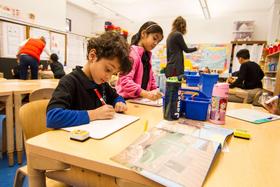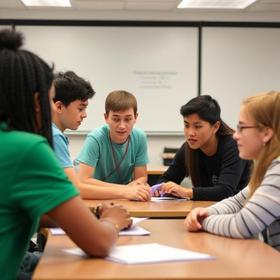Serving 245 students in grades 5-8, Thomas Hunter Middle School ranks in the bottom 50% of all schools in Virginia for overall test scores (math proficiency is bottom 50%, and reading proficiency is bottom 50%).
The percentage of students achieving proficiency in math is 53% (which is lower than the Virginia state average of 68%). The percentage of students achieving proficiency in reading/language arts is 62% (which is lower than the Virginia state average of 69%).
The student-teacher ratio of 11:1 is lower than the Virginia state level of 14:1.
Minority enrollment is 23% of the student body (majority Black and Hispanic), which is lower than the Virginia state average of 56% (majority Black).
Quick Facts (2025-26)
- Grades: 5-8
- Enrollment: 245 students
- Student-Teacher Ratio: 11:1
- Minority Enrollment: 23%
- Overall Testing Rank: Bottom 50% in VA
- Math Proficiency: 53% (Btm 50%)
- Reading Proficiency: 62% (Btm 50%)
- Science Proficiency: 40-44% (Btm 50%)
- Source: National Center for Education Statistics (NCES), VA Dept. of Education
Top Rankings
Thomas Hunter Middle School ranks among the top 20% of public schools in Virginia for:
Category
Attribute
Community Size
Student Attention
School Overview
Thomas Hunter Middle School's student population of 245 students has declined by 24% over five school years.
The teacher population of 23 teachers has declined by 14% over five school years.
Grades Offered
Grades 5-8
(Primarily virtual)
(Primarily virtual)
Total Students
245 students
Gender %
Total Classroom Teachers
23 teachers
School Rankings
Thomas Hunter Middle School ranks within the bottom 50% of all 1,773 schools in Virginia (based off of combined math and reading proficiency testing data).
The diversity score of Thomas Hunter Middle School is 0.40, which is less than the diversity score at state average of 0.72. The school's diversity has stayed relatively flat over five school years.
Overall Testing Rank
#1355 out of 1773 schools
(Bottom 50%)
(Bottom 50%)
Math Test Scores (% Proficient)
53%
68%
Reading/Language Arts Test Scores (% Proficient)
(20-21)62%
69%
Science Test Scores (% Proficient)
(20-21)40-44%
59%
Student-Teacher Ratio
11:1
14:1
American Indian
1%
n/a
Asian
1%
8%
Hispanic
6%
19%
Black
8%
22%
White
77%
44%
Hawaiian
n/a
n/a
Two or more races
7%
7%
All Ethnic Groups
Eligible for Free Lunch
72%
55%
Eligible for Reduced Lunch (21-22)
8%
5%
School Statewide Testing
School District Name
Source: National Center for Education Statistics (NCES), VA Dept. of Education
Profile last updated: 02/09/2025
Frequently Asked Questions
What is Thomas Hunter Middle School's ranking?
Thomas Hunter Middle School is ranked #1355 out of 1,773 schools, which ranks it among the bottom 50% of public schools in Virginia.
What percent of students have achieved state testing proficiency in math and reading?
53% of students have achieved math proficiency (compared to the 68% VA state average), while 62% of students have achieved reading proficiency (compared to the 69% VA state average).
How many students attend Thomas Hunter Middle School?
245 students attend Thomas Hunter Middle School.
What is the racial composition of the student body?
77% of Thomas Hunter Middle School students are White, 8% of students are Black, 7% of students are Two or more races, 6% of students are Hispanic, 1% of students are American Indian, and 1% of students are Asian.
What is the student-teacher ratio of Thomas Hunter Middle School?
Thomas Hunter Middle School has a student ration of 11:1, which is lower than the Virginia state average of 14:1.
What grades does Thomas Hunter Middle School offer ?
Thomas Hunter Middle School offers enrollment in grades 5-8 (Primarily virtual).
What school district is Thomas Hunter Middle School part of?
Thomas Hunter Middle School is part of Mathews County Public Schools.
School Reviews
2 10/10/2025
The quality of academic program is insufficient because the teachers don't teach, the teachers rely on the students to teach themselves or its the parent job to teach. The teachers especially Hutchinson, Riddick and McLaughlin(how can she still teach after stealing basketball money from fundraisers)should not have any exposure to children. These three teachers really don't have the mentality to teach students(their mentality is still in elementary school). Papas is a joke and exactly what does he do besides cussing at the students. Deputy Hall needs to mentally mature and learn how to tell the truth. Overall the teachers/dare officer/principle all need to go. The respect factor is so low towards the parents. The attitude of the whole school is awful and if Mathews cares they would clean house. The part I love is if your child is in a fight no matter what age, the principle does not do anything but turn them over to Hall(dare officer) then they waste our tax dollars because you end up in court, so our tax dollars go to papas and court. One should be eliminated.
Review Thomas Hunter Middle School. Reviews should be a few sentences in length. Please include any comments on:
- Quality of academic programs, teachers, and facilities
- Availability of music, art, sports and other extracurricular activities
Recent Articles

Bullying, Name-Calling & Put-Downs: Parent Guide 2025
Practical tips for parents to address bullying, name-calling, and put-downs鈥攚ith 2025 data, policies, and expert strategies.

What Is a Magnet School? (2025 Guide)
Explore what a magnet school is, how it works, and its benefits in 2025. Clear explanation for parents, students, and educators.

Cooperative Learning in 2025: Evidence, Best Practices & Challenges
Explore cooperative learning in 2025鈥攏ew data, updated practices, expert insights for educators and families.





